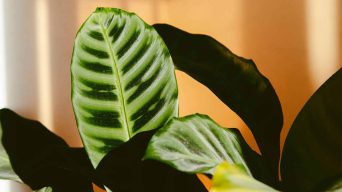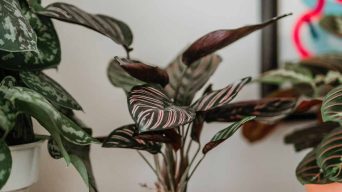Are you looking for a way to add some greenery and texture to your home?
Calathea plants are a great option. Not only do they have beautiful, unique leaves, but they’re also easy to care for.
However, one common issue with calathea plants is the legginess or stretching of the stems. If your calathea plant, also known as the prayer plant, is starting to look tall and spindly, don’t worry!
In this article, we will discuss what causes leggy calatheas and how you can fix it – so that your prayer plant looks lush and full again in no time.
How Can You Tell if a Calathea Is Leggy?
Knowing the signs of a leggy calathea is essential for keeping your plant healthy. By recognizing these signs early on, you can make adjustments to better care for your prayer plant and prevent further damage.
The most obvious signs of a leggy calathea are:
Long, Thin Stems
Leggy calatheas typically have longer and more slender stems than healthy ones. If your prayer plant has multiple branches that are noticeably longer than the rest, it’s likely leggy.
Fewer Leaves
Another common sign of a leggy calathea is fewer leaves than usual. If the plant’s stem isn’t growing any new leaves, it may be because it doesn’t have enough energy to support them. Instead, the stem will focus on growing taller to reach more light and energy-giving sunlight.
Stretched Out Leaves
Leggy calatheas may also have stretched-out and pointy leaves rather than being full and lush. This is a sign that the plant has reached for the light and isn’t getting enough from its environment.
Spaced-out Leaves
A leggy calathea may also have leaves spaced far apart and not growing in clusters as they would normally. If the stems and leaves of your plant are widely dispersed, it could be suffering from a lack of energy or light.
Lack of New Leaf Growth
When a calathea isn’t receiving enough energy, it won’t be able to produce new leaves. If you’re not seeing any growth on your plant, and it looks very thin, it’s likely suffering from legginess.
Pale Leaves
Leggy calatheas typically have pale or yellowish-looking leaves. This may indicate that the prayer plant isn’t receiving enough light, so it cannot produce healthy green foliage. Although it won’t always be the case, pale leaves often indicate legginess in calathea plants.
Drooping Leaves
Leggy calathea plants may also have drooping leaves as they don’t receive enough energy to keep them upright. If your calathea plant has droopy leaves, it may not get enough light or energy to support them.
Weak or Unhealthy Appearance
Leggy calatheas may also look visibly weak and unhealthy. If your plant looks thin, with few leaves spread out over its stem and pale foliage, it’s likely leggy. This could be due to poor environmental conditions or inadequate care.
What Causes Legginess in Calathea Plants?
Leggy calathea plants can be caused by several factors. The most common reasons are:
Lack of Adequate Light
Low light conditions can cause legginess in calathea plants. Calatheas prefer to grow in bright indirect light; without enough light, the stems will stretch out, seeking the sunniest windowsill or brightest porch corner.
This stretching, called etiolation, causes the stems and leaves to look thin and weak. To prevent legginess, keep your calathea plant in a spot that receives bright indirect sunlight or use artificial lighting to supplement natural light.
Temperature Fluctuations
Calathea plants prefer a steady warm temperature between 18 and 27 degrees Celsius (65 to 80 F). Temperature fluctuations, especially cooler temperatures, can cause legginess.
Make sure your Calathea is in a spot away from drafts and that any air conditioning unit is not directly blowing on it.
If the temperature drops too low, it can cause the calathea leaves to turn yellow or brown, which means the plant has been exposed to cold temperatures for too long. In more severe cases, your calathea may even die.
With these plants, it’s best to keep the temperature consistent and avoid sudden temperature changes.
Improper Fertilization
Fertilization is important for the health of your calathea plant.
Too little fertilizer can cause the leaves to become weak and discolored, while too much fertilizer can lead to leggy growth. This is because too much fertilizer can upset the balance of nutrients in the potting soil, leading to overly fast growth.
If you want to fertilize your calathea plant, do it sparingly – just once or twice a month – and always use a balanced fertilizer.
Lack of Pruning
Leggy calathea plants can become leggy if not pruned regularly. Pruning a calathea plant helps to promote bushier, healthier growth and keeps the plant looking good.
Calatheas can grow quickly, so you should trim them every one to two months. Pruning helps keep your calathea plant balanced, preventing the stems from stretching out and getting too long.
To prune your calathea, snip off dead leaves or stems that don’t look healthy. This will help encourage new growth and keep your calathea plant looking lush.
Rootbound Condition
If your calathea plant is in a pot that’s too small, it may become rootbound. This means the roots have filled up all of the space in the pot, leaving no room for new growth.
Rootbound plants are usually leggy because they don’t have enough nutrients to fuel their growth. To fix this, you’ll need to repot your calathea in a larger pot. Make sure the new pot is twice as wide as the previous one and has adequate drainage holes.
When you repot, loosen the roots gently with your hands and make sure there are plenty of soil pockets for oxygenation.
How Can You Fix a Leggy Calathea Plant?
If you’re dealing with leggy Calathea plants, the first step is to try and understand what caused it in the first place.
Legginess can be triggered by factors such as lack of light, too much fertilizer, or temperatures fluctuating too quickly.
Once you have identified the potential cause of the legginess, you can take steps to correct it.
Here are some tips for fixing a leggy Calathea plant:
1. Increase Light
Calatheas prefer bright, indirect light and must be kept away from direct sunlight to stay healthy.
If your calathea gets too little light, it can become leggy as it attempts to reach the sun’s rays.
Move your plant closer to a light source, such as a window or artificial grow lights, to provide more light and help improve your plant’s health.
2. Reduce Fertilizer
A leggy plant can be an indicator of too much fertilizer.
Fertilize only once a month during the growing season and reduce the amount you give your plant to prevent further legginess. Use a balanced fertilizer and dilute it at half-strength.
You may need to flush the soil to remove any excess fertilizer buildup, which can also cause legginess.
3. Provide Consistent Temperatures
Calatheas thrive in warm, humid environments, and sudden temperature shifts can cause legginess.
Maintain consistent room temperatures (between 65-80°F) and keep the humidity around your plant at a comfortable 50%.
You can use a humidifier or place the pot on top of a tray of wet pebbles to create a humid microclimate around the plant.
4. Repot in Fresh Soil
Rootbound plants become leggy as they compete for nutrients in an overcrowded pot.
Provide a new home with plenty of room to grow by repotting it with fresh, nutrient-rich potting soil and a larger container. Use a pot large enough to give your Calathea plenty of space to spread its roots.
Repotting your calathea also helps to flush out any built-up salts or minerals from the old soil.
5. Prune to Encourage New Growth
If your Calathea is leggy, you can trim the longer, lankier stems and leaves to encourage new growth.
Prune back the affected areas to a few inches above the soil line and discard any dead or damaged foliage. Pruning also helps to maintain an attractive shape while maintaining its overall health.
Step-by-Step Guide for Pruning Leggy Calathea Plants
- Clean the pruning shears with alcohol before and after pruning.
- Inspect your Calathea to identify any leggy stems or leaves.
- Use pruning shears to cut away the affected areas about a few inches above the soil line.
- Remove any dead or damaged foliage still attached to the plant.
- Discard any debris and dispose of it properly.
- Place the Calathea in a spot with good lighting and consistent temperatures.
- Water the Calathea often enough to keep the soil moist but not soggy.
- Give your Calathea enough time to adjust to the pruning and start forming new growth.
- Provide your Calathea with proper care and regular feeding to promote healthy growth.
- Check your plant regularly for any signs of pests or disease.
After a few weeks, you should see new leaves sprouting from the plant’s base.
Routinely inspect your Calathea for any new signs of legginess and prune them as needed. Regular pruning also helps to maintain its shape and keep it looking attractive.
How Can You Prevent a Leggy Calathea?
Prevention is the best cure for keeping your calathea plants looking healthy and vibrant.
To keep your leggy calatheas from getting too tall and slim, there are a few key steps you can take:
1. Ensuring Proper Light Conditions
Calathea plants thrive in bright indirect light, away from any direct sunlight. Ensure that you provide the right amount of light for your plant – too much can cause it to become leggy and stretched out, while not enough will stunt its growth.
Place your calathea in an area of your home that gets ample indirect light. East- or west-facing windows are ideal spots.
You should also consider the time of year – during winter, you may need to supplement natural light with a grow light for best results.
2. Regular Plant Rotation
Your calathea will benefit from regular rotation so that each side gets an equal amount of light. This will help your plant to grow evenly and not become overly leggy on one side.
To rotate the plant, gently pick up the pot and turn it by a quarter or half in the same direction every week or two.
3. Avoiding Shade from Other Plants or Objects
Be mindful of other plants or objects that may cast shadows on your calathea. If any part of the plant isn’t getting enough light, it will become leggy to reach for more light.
If you notice this happening, move the plant or rearrange nearby objects to ensure even, indirect light throughout.
By following these simple steps and providing your calathea with the right environment and care, you can prevent your plant from becoming leggy and enjoy its lush, vibrant foliage for years to come.
4. Regular Trimming
Regularly trimming any overly leggy shoots can help encourage bushier, fuller growth and prevent it from becoming too tall.
Using sharp, clean pruning shears, snip off any shoots growing in an undesirable direction or stretched out too far. This will also help create a more balanced shape for your calathea.
Remember to trim off any yellowed or brown leaves, as these are signs of poor health and may indicate an overall lack of light.
5. Proper Fertilization
Giving your calathea the right amount of fertilizer will help it to thrive and prevent it from becoming leggy.
Feed your plant with a high-quality, balanced liquid fertilizer during the growing season (spring through fall). Be sure to dilute the solution according to the manufacturer’s instructions and discontinue fertilizing during winter.
Overfertilization leads to leggy, stretched-out growth, so be sure not to overdo it.
6. Temperature and Humidity
Leggy growth can be caused by too-cold temperatures or dry air. Calatheas thrive in warm and humid environments – ideally, between 65-80°F (18-27°C).
Try to keep your plant away from any cold drafts or vents that could cause it to become leggy.
You should also maintain a consistent level of humidity – the ideal range is between 60-80%. Place a humidity tray beneath the pot or use a humidifier to boost the air moisture content.
7. Regular Monitoring
Finally, check on your calathea regularly and inspect it for signs of leggy growth.
If you notice any shoots starting to get too tall or stretched out, take steps to prevent further stretching by adjusting light levels or trimming back the shoots.
By being mindful of your calathea’s needs and paying close attention to its growth, you can keep it healthy and prevent it from becoming leggy.
Final Thoughts
Preventing a leggy Calathea plant isn’t complicated—it simply requires the right environment and care.
Ensure that your plant is kept in bright indirect light and the soil is always moist.
Make sure to keep fertilizer use low, as Calatheas prefer to be slightly underfed rather than overfed.
Finally, ensure that the air around your calathea isn’t too dry or cold; a humidifier can help maintain the plant’s preferred high humidity level and ward off legginess.
With the proper care, you won’t have to worry about your Calathea falling victim to this common issue.







